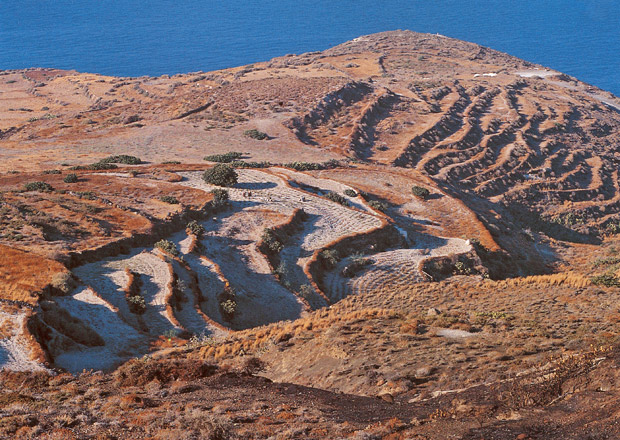The following eruption resulted in the creation of Nea Kameni island and it took place in 1570-1573 AD. Nea Kameni emerged from the fire and the streams of the volcano, four kilometers away from Nea Kameni. It consisted of a crater from where rocks and ash were erupted.
During the year 1649 AD there was an intense seismic activity in Thera and on September 1650, locals noticed smoke and steams rising from the sea, seven kilometers away from cape Koloumbos, to the northeast. A pumice eruption followed and the dust of it was transferred to Asia Minor by the wind. The island that was created after that eruption sank in the sea creating a submarine volcano that was named Koloumbos. It is 18 meters under the sea level and it has an oval shaped caldera. One can see the submarine hot springs located near the coast, when the sea is calm.

Kolumbo cape to the east of Santorini
Kolumbo is a submarine volcano located 8 km away from Cape Kolumbo, to the northeast of Santorini island. It is a part of the volcanic complex of Santorini and it is a “hidden” volcano, given that it is not visible on the earth. Kolumbo, also known as Kolumbos by the locals, emerged from the sea during the volcanic activity that took place in 1649-1650. Submarine investigations carried out by experts, brought to light a great deal of interesting information concerning the hidden volcano.
According to one myth, among several related to the name of the volcano, its name derives from the greek verb “kolymbo” (swim) and it is due to the fact that Kolumbo appeared and disappeared from the sea surface very often during its volcanic activity, looking like a man who was swimming.
The dimensions of its cone are 4 and 8 km and the highest point of its crater is at 18 m under the sea level. A caldera has been created in the central area of Kolumbo volcano and the deepest point of this caldera is at 51 m under the sea level.
This eruption had serious impacts on the island and it was named as the “Bad era” by the habitants of the island. More than 50 people as well as a lot of animals died due to the poisonous gases while all corps was destroyed. Two churches in Perissa and Kamari were demolished and washed up to the sea by a tidal wave which managed to bring to light the foundations of a very old church as well as of small marble statues which date back to the Hellenistic era. These tidal waves were due to the strong volcanic eruption.
According to scripts written by eye-witnesses, the flames of that eruption were visible even to Heraklio, Crete island which was 120 kilometers away from the volcano. Crete was under Ottoman occupation during that period and it is witnessed that the Ottoman ships were anchored at the coast of Dias island, to the north of Heraklion, were washed up by the tidal waves caused by the eruption.
